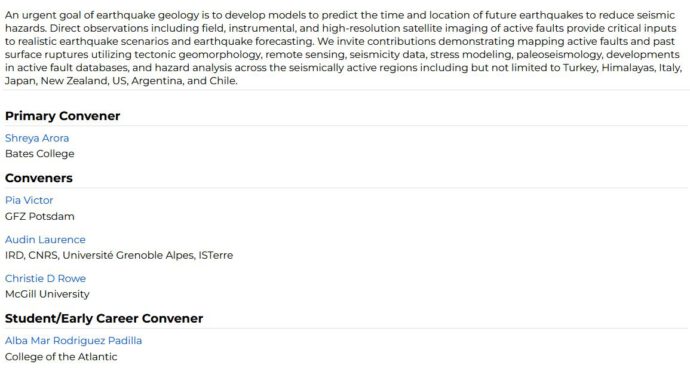In a new study, Rosell et al. look into the earthquake history of the Tambomachay Fault near Cusco in Peru. Cusco has been hit by damaging earthquakes in 1650, 1950, and 1986, and there is also some evidence for another earthquake during Inca times between AD 1418–1471. Very little is known about the causative faults. There is also very limited information on older events. The closest fault to the city is a 20 km-long normal fault at the northern margin of the Cusco Basin, the Tambomachay Fault. Here we constrained the fault’s Holocene slip rate by dating offset lateral moraines, and we identified three Holocene surface ruptures in a paleoseismological trench. The study was recently published open access in τeκτoniκa.
morePosts in the category » « ( 303 Posts )
-
New Paper: Holocene earthquakes near Cusco, Peru
2023-12-08 | in Paper -
New papers on paleoseismology, active tectonics, and archaeoseismology (Dec 2023)
-
New papers on paleoseismology, active tectonics, and archaeoseismology (Nov 2023)
2023-11-01 | in PaperThis has become a long list again, and I partly blame the New Zealanders who are currently publishing a lot of studies related to their new hazard model. Really cool work! But of course the inclined readers will also find other gems for their taste. As always – please send me paleoseismology studies that I have missed. Enjoy reading!
more -
Save the date: 12th INQUA PATA Days will be held in Los Andes, Chile, 6-11 October, 2024
2023-10-30 | in PATA days | 7 responsesThe 12th international PATA Days will be held in Los Andes, Chile, 6-11 October, 2024. PATA stands for Paleoseismology, Active Tectonics, Archaeoseismology and it is the main activity of the paleoseismology community within INQUA’s TERPRO commission.
more -
New papers on paleoseismology, active tectonics, and archaeoseismology (Oct 2023)
2023-10-07 | in PaperMore and more papers emerge on the February, 2023 earthquakes in Turkey and the East Anatolian Fault System. Additionally, we have a database of paleoseismology studies in New Zealand (spoiler: it’s a lot!) and many more papers on paleoseismology and tectonic geomorphology. Enjoy reading!
more -
New papers on paleoseismology, active tectonics, and archaeoseismology (Sep 2023)
-
New papers on paleoseismology, active tectonics, and archaeoseismology (Aug 2023)
-
AGU Session S014 – Field observations, instrumental and high-resolution satellite imaging: A vision of improved active tectonics/paleoseismology hazard assessment.
2023-07-24 | in MeetingAGU has lots of interesting sessions to offer for paleoseismologists. Our colleague Pia Victor invites contributions to her session with Shreya Arora, Laurence Audin, Christie D Rowe, Alba Mar Rodriguez Padilla: Field observations, instrumental and high-resolution satellite imaging: A vision of improved active tectonics/paleoseismology hazard assessment.

-
2nd circular for the TERPRO INQUA summer school on Active Faults and Volcano-Tectonics
-
New papers on paleoseismology, active tectonics, and archaeoseismology (July 2023)
2023-07-03 | in PaperFor many geologists the field season is up ahead or has already started, but perhaps you will find some time to read through the latest literature? Or you can use the winter season in the southern hemisphere to enjoy a good read? It would be a pity to miss some of these really interesting studies. Enjoy!
more
